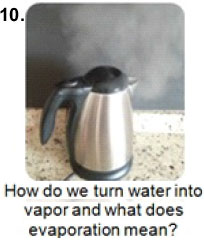Serviços Personalizados
Artigo
Indicadores
Links relacionados
-
 Citado por Google
Citado por Google -
 Similares em Google
Similares em Google
Compartilhar
South African Journal of Education
versão On-line ISSN 2076-3433
versão impressa ISSN 0256-0100
S. Afr. j. educ. vol.34 no.3 Pretoria Mar. 2014
A study on preschoolers' conceptual perceptions of states of matter: a case study of Turkish students
Murat DemirbaşI; Nurcan ErtuğrulII
IKirikkale University, Education Faculty, Science Education Department, Yahjihan, Kirikkale/Turkey muratde71@gmail.com,
IIKirikkale University, Institute of Natural Sciences, Yahjihan, Kirikkale/Turkey nurcanertugrul@hotmail.com
ABSTRACT
The purpose of the present study is to identify preschoolers' conceptual perceptions of states of matter, this issue that they often come across in their daily and social life. The study was designed as a qualitative case study. The population of the study was comprised of 25 preschoolers studying at two primary schools located in Kirikkale and Kirşehir, Turkey. The data were collected through the Science Concepts Perception Test (SCPT), which contained 10 semi-structured questions suitable for the level of preschoolers. The data were subject to content analysis, a qualitative method of data analysis, in order to identify how the students perceived science concepts.
Keywords: concept education, misconceptions, misconceptions about matter, perception test, pre-school education, primary education, science education, Turkish students.
Introduction
Starting with childhood, human beings learn about concepts, which are units of ideas, and words, which are their names, as well as classifying concepts and forming connections between them. In this way, they give meaning to what they are learning and generate new knowledge. Such learning continues in human mind regardless of one's age. Concepts are names that we assign to things, phenomena, humans and ideas by grouping them depending on their similarities. Concepts are building blocks for knowledge whereas connections between them constitute scientific principles. Concepts are not concrete but abstract thoughts; they exist in one's thought system rather than in the outside world (Cepni, Ayas, Johnson & Turgut, 1997). A concept is a word that is more often used to name objects or things. Starting from infancy, human beings learn about concepts. As they get older, they start structuring these concepts through their experiences, which is a life-long process (Novak & Gowin, 1984 as cited in Kilinç, 2007).
Sciences and Concept Learning
Humans learn about concepts not through memorization but by studying opposing examples. If students are allowed to establish and test their own hypotheses, and concepts are presented in a concrete way, a greater contribution can be made to their development of concepts. It is a well-known fact that concepts are learned starting from birth. Therefore, students should be enabled to develop basic concepts first, subsequently proceeding to use them to generate new information in reference to their similarities and differences (Cepni, Ayas, Akdeniz, Özmen, Yiğit & Ayvaci, 2008).
Concept learning is a planned activity carried out at schools. It consists of two stages, namely concept formation and concept attainment. The former is a prerequisite for the latter. Concept formation pertains to descriptive knowledge while concept attainment is about operant knowledge. Concept formation is most common in childhood, although it lasts for a life-time. Children who start learning at a school are often not beginners when it comes to concepts. They have perceptions, whether they are right or wrong, about properties of concepts to some extent (Ülgen, 2004). Today's approaches to teaching acknowledge that permanent learning is not operant but conceptual (Çepni et al., 1997). A number of approaches have been proposed and tested in particular curricula to explain how learning works and what kind of mental construct leads to it. In recent years, one alternative approach, constructivism, has been developed and included in the Turkish curriculum; constructivism involves a lot of methods and techniques and asserts that learning happens as a result of an active process (Evrekli, İnel, Balim & Kesercioğlu, 2009).
In order for meaningful learning to take place in constructivism-based teaching, learners are supposed to form a connection between their previous learning and experiences and new learning situations, to construct knowledge rather than memorize it, and to adjust themselves to it. Basic building blocks for one's cognitive structure, concepts, as maintained by constructivism, play a key role in efficient and permanent learning (Malatyali & Yilmaz, 2010).
The Processes of Concept Development in Sciences Concepts are formed in human mind. One of the processes whereby concepts are developed is generalization. In general, one attempts to group objects or things under certain groups by their similarities. He/she develops concepts by making generalizations depending on their experiences and observations. Another process of concept development is distinction. In this process, one is involved in coming up with categories by taking into account the distinctions between objects or situations. Definition is another process of concept development. In this type of concept development, verbal expression of ideas in our minds involves the process of defining concepts (Kilinç, 2007). Concepts are formed in different ways. These ways are influenced by individual learning, prior knowledge about a given subject, and evaluation. Whereas concrete concepts are structured in a different way, it is more complicated to form abstract concepts such as politics and faith (Carey, 2009).
It is known that concept teaching is significant in physical sciences. Therefore, science educationalists have focused on concepts for teaching students about science subjects rather than conducting studies on general subjects (Coştu, Ayas & Ünal, 2007). It is essential that students should use and understand science and technology terminology. In order to help them gain and use science and technology terminology, students should always be encouraged to express what they have learned and to use new concepts (The Ministry of National Education [MEB], 2006).
As a matter of fact, it has recently been acknowledged that students' early perceptions of science concepts are so important to assess their understanding of scientific events and to enhance science education (Çalrk & Ayas, 2003). The period of preschool education, which takes places between the ages of zero and six, is one of the periods that witness fast physical, mental and social development on the part of students (Poyraz & Dere, 2003). Kalley and Psillos (2001) maintain that it is during this period that basic science concepts start to get formed (as cited in Karamustafaoğlu & Kandaz, 2006).
Science Teaching and Misconceptions
The information that a student has acquired before entering the classroom will have an influence on his/her future learning. Erroneous information brought by a student into the classroom is called misunderstanding, alternative conception, or misconception. The process by which such information is replaced by correct information is described as conceptual change. One of the many methods of eliminating misconceptions is conceptual change texts. When an attempt is made to eliminate misconceptions, students should be convinced that what they already know is wrong, new information should be presented in a clear and explicit way, and it should be not only meaningful but also useful (Çepni et al., 2008).
Misconceptions are acknowledged to be caused by many unfamiliar words included in a subject, erroneous information in textbooks, inability to associate concepts with daily life, and different connotations of concepts in daily life (Şendur, Toprak & Şahin Pekmez, 2008). What we already know is continuously replaced by newly-acquired information. In fact, what we have learned as scientific information could turn out to be a misconception. Concepts are of a complicated structure that can be modified as a result of new observations, facts, and ideas (Zirbel, 2004).
Language enables one to form new concepts. As with natural selection, more complicated concepts are thought about and formed in a holistic way. Similarly, more abstract concepts can be formed by means of theories in mathematics, such as the one about the Big Bang. In other words, concepts help us to make deductions in a given structure and explain more complicated ideas (Zirbel, 2004).
Teachers should enable their students to actively structure the concepts they have acquired. In this respect, students should be made to get involved in higher-level thinking, analysis, synthesis, and evaluation. While teaching animals and plants, for example, a teacher should organize those activities that allow students to detect the distinctions between concepts, to come up with new concepts, and to adapt what they have learned to new situations, instead of simply presenting them with potential facts about animals and plants (Birbili, 2007). Concepts learned in a detailed way are better structured and associated. In-depth thinking leads to formation of new structures on the basis of what is already known (Zirbel, 2005).
As part of pre-school education, science activities not only contribute to the realization of the objectives and attainments specified in the science curriculum but also help children acquire basic concepts and develop science process skills. According to Kamay and Kaşker (2006), experiences that children have during this period provide them with a favorable environment for acquiring concepts, which are building blocks for knowledge. Children are observed to construct and use these concepts in their daily life. During this period, children learn about and start to use basic math and science concepts. Acquired in early childhood, these concepts play a pivotal role in the development of abstract scientific concepts in later years. In order to determine the extent to which concepts could be developed, Awan, Khan, Mohsin and Doger (2011) conducted a study in which tenth grade students were asked to provide their opinions as to the components of matter. They concluded that these students had too many misconceptions. In their study, Thomson and Logue (2006) analyzed the misconceptions of six students of varying ages about floating of light and heavy objects, rain clouds and classification of animals. Similarly, they discovered that the students had misconceptions. In another study, Nadeem, Sadaf, Parveen and Iqbal (2013) investigated primary school textbooks in reference to several criteria. They asserted that textbooks with inadequate visuals might cause students to develop misconceptions. In another study, Kubiatko and Prokop (2009) asked for the opinions of students that were 10 to 15 years old about mammals. With this purpose in mind, they designed a measuring instrument that contained 35 multiple-choice questions. They concluded that each age group experienced misconceptions. In another study, De Villiers (2011) asked prospective teachers to comment on the science curriculum in South Africa. The participants reported that it was more difficult to learn biodiversity, change and continuity. Botha and Reddy (2011) emphasized the importance of knowledge acquired by prospective teachers during pre-service training and stressed that such knowledge should be acquired in a meaningful way.
Aim of the study
Science education for preschoolers should be shaped in a way that will cover all the countries in the world, not just developed ones. Considering this, the results of the present study, which is on preschoolers, and sample findings will hopefully be useful for such students in South Africa, too. In this way, the findings will guide future amendments as well as ensuring an identification of what can be done. It is essential to know how students understand concepts starting from childhood and what factors are involved in the process. In this way, preschool teachers will be able to know what ideas children have about matters, thereby planning instructional activities accordingly. In this respect, the findings of the present study will hopefully provide data for similar studies in other countries on the same age group. The purpose of the present study is to identify preschoolers' conceptual perceptions of states of matter, this issue that they often come across in their daily and social life.
In this respect, the following research questions were posed:
1) What are students' perceptions of the concept "solid"?
2) What are students' perceptions of the concept "liquid"?
3) What are students' perceptions of the concept "gas"?
4) What are students' perceptions of the concept "melting"?
5) What are students' perceptions of the concept "freezing"?
6) What are students' perceptions of the concept "evaporation"?
Methodology
Study Model
The study was designed as a case study, a qualitative research model, to determine preschoolers' conceptual perceptions of states of matter. Case studies are used as a distinguishing approach to seek for an answer to scientific questions. They are defined as a method that explores one or more events, environments, programs, social groups or other interdependent systems (Büyükoztürk, Çakmak, Akgün, Karadeniz & Demirel, 2008).
The population of the study was decided upon through criterion sampling. The basic principle of criterion sampling is that one studies all situations that meet a number of criteria specified in advance (Yildirim & Şimşek, 2008). The criterion for the present study was that the participants were supposed to be six years old and to be attending a kindergarten.
Sample of Study
The study was conducted on a total of 25 preschoolers who studied at two primary schools located in Kirikkale and Kirsehir, Turkey, during the 2011-2012 Academic Year. Table 1 presents the distribution of the students by gender.
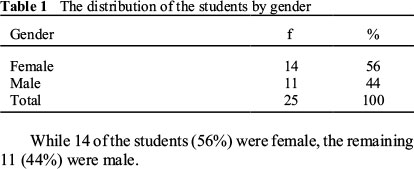
While 14 of the students (56%) were female, the remaining 11 (44%) were male.
Data Collection Instrument
The researchers designed a data collection instrument to identify the students' conceptual misconceptions about states of matter. Before the researchers developed the measurement tool, they had analyzed studies on the extent to which concepts about states of matter could be understood. In this way, they attempted to determine how preschoolers formed concepts (Erdem, Yilmaz, Atav & Gücüm, 2004; Şendur et al., 2008; Co°tu et al., 2007; Devetak, Vogrinc & Glažar, 2010; Awan et al., 2011).
The first draft contained questions as to solids, liquids, gases, melting, freezing, evaporation. It was submitted to three individuals specializing in science education and preschool education so as to make sure that the questions could identify the students' perceptions of science concepts and that they were appropriate for the level of preschoolers. The questions were rearranged in accordance with learned opinion. The final draft had 10 semi-structured questions embellished with certain pictures. The instrument was called The Science Concepts Perception Test (SCPT). The items and the concepts they correspond to are presented below. (Appendix: 1).
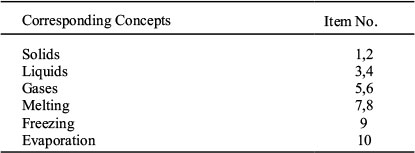
In order to make sure that the data were reliable, the themes designed by the researchers were submitted to certain researchers competent in qualitative research and they were asked to comment on the suitability of the structure. Afterward, a comparison was made between the categories of the researchers and those of the experts so that the number of agreements and disagreements would be determined. Next, the reliability of the study was tested through Miles and Huberman's (1994) formula (Reliability = number of agreements/total number of agreements + disagreements). In qualitative research, an agreement of 90% and more between the expert and researcher is accepted as desired reliability level. Two disagreements were revealed as to the themes, which meant that the reliability was 76/76+2 = 0.97.
Data Collection Process
The data were collected through the SCPT in May, 2012. Since the students were not able to read or write yet, each question was addressed to the students separately and their answers were recorded in a written way. Moreover, the records were read aloud in order that they could be confirmed by the students.
Data Analysis
The data were subject to content analysis. Content analysis is a systematic and replicable technique in which some words of a text are summarized with smaller content categories in reference to the coding based on certain rules (Büyükoztürk et al., 2008). First, the data were divided into meaningful parts and an attempt was made to determine the conceptual meaning of each part. During the process, the parts that could make up a meaningful whole were coded; the similarities and differences between the codes were evaluated. The next step was to theme interdependent codes. Finally, the themes were supported by direct quotations from the students.
Findings
Perceptions of Solids
Question 1. (Concerning the picture that contains a comb, tea and vapor) Which one resembles wood and why? The students' answers were grouped under three headings given in Table 2.
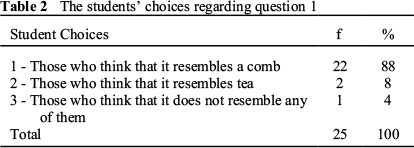
Whereas 88% of the students thought that wood resembled a comb, 8% of them believed that it resembled tea. However, 1% of them thought that wood did not resemble either a comb or tea or vapor. Out of 22 students who thought that wood resembled a comb, 10 did not prove any justification. An analysis was made of the justification provided by the remaining 12 students and related findings are presented in Table 3.

The underlying reasons given by the students were that both were hard and solids. Some of their answers are as follows:
S1 It resembles a comb, because it is hard. S8 Both comb and wood are solids. S19 It resembles a comb, because we can hold them both. S4 It does not resemble any of them. S11 It resembles tea.
Question 2. (Concerning the picture that contains a nylon bag, rope, fabric, pencil, rubber band and eraser) Which one is a solid and why? The students' responses to the question are presented in Table 4.
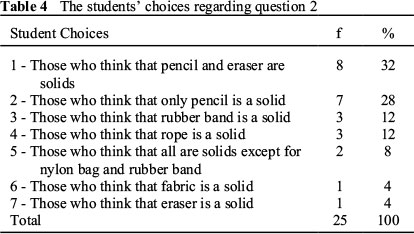
While 32% of the students reported that pencil and eraser were solids, 28% of them regarded only pencil as a solid. Another 12% believed that rubber band was a solid. The remaining students considered rope, all except for nylon bag and rubber band, fabric and eraser as a solid by 12%, 8%, 4% and 4% respectively. The themes regarding their justification are presented in Table 5.
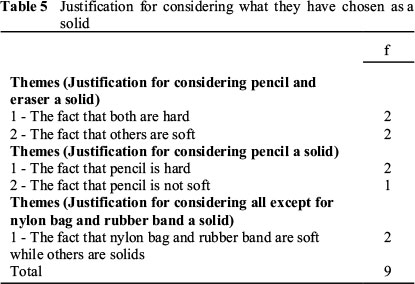
An analysis of the answers suggests that the students mostly emphasized the hardness of things or their lack of softness. Some of their answers are as follows. S1 Pencil is a solid, because it is hard; others are soft. S22 Pencil and eraser are solids; others are soft. S2 Solid things are hard; neither rubber band nor nylon bag is a solid. S19 Pencil and eraser are solids, because both are hard. S20 Pencil is a solid, it cannot be soft.
An analysis of the answers to the questions suggests that the students could distinguish solids among others and that they could provide new examples of solids. Even so, they thought that the only criterion for something to be a solid was to be hard; thus, they did not regard soft or flexible things as a solid.
Perceptions of liquids
Question 3. (Concerning the picture that contains olive oil, candle and molasses) Which one is a liquid and why? The students' answers to the question are presented in Table 6.
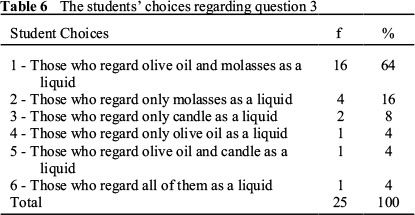
Nearly two-thirds of the students (64%) reported that olive oil and molasses were liquids whereas 16% of them regarded only molasses as a liquid. While 8% of the students considered candle as a liquid, 4% of them reported that only olive oil was a liquid. Another 4% reported that both olive oil and candle were liquids. Finally, 4% of the students considered all of them as a liquid. Out of 16 students who reported that olive oil and molasses were liquids, five did not provide any justification. An analysis was made of the justification provided by the remaining 11 students and related findings are presented in Table 7.
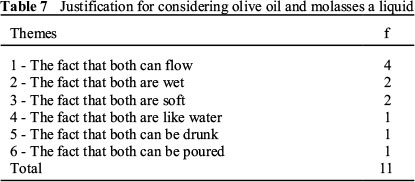
The students based their answers on the fact that olive oil and molasses could flow, that they were wet, soft and like water, and that they could be drunk and poured. In fact, all these statements suggest how they perceived liquid. Some of the answers are as follows.
S2 Liquids flow, so olive oil and molasses are liquids. S21 Olive oil and molasses are liquids, because they are both like water. S4 Molasses and olive oil are liquids, because both are soft. S1 Molasses and olive oil are liquids, because they can be poured. S23 Molasses and olive oil are liquids, because they make our hands wet.
Question 4. (Concerning the picture that has lentil, salt and soup). Which one resembles coffee and why? The answers to the question were grouped under three headings presented in Table 8.
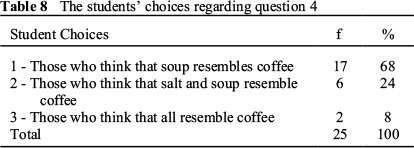
Whereas 68% of the students thought that soup resembled coffee, 24% of them reported that both salt and soup resembled coffee. The remaining 8% believed that all of them resembled coffee. An analysis of the justification by the students is presented in Table 9.
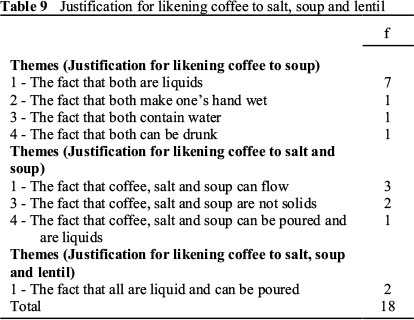
The underlying reason why certain students likened coffee to soup was that both were liquids. Even so, some students considered salt as a liquid. Some of their answers are as follows. S1 Coffee resembles soup; both are liquids. S19 Coffee resembles soup; both make our hands wet. S4 Coffee resembles salt and soup, because it can flow. S7 Coffee resembles salt and soup; it is not a solid. S8 Coffee resembles all of them; all are liquids and can be poured.
An analysis of the answers to questions suggests that the students could distinguish liquids from others, that they defined liquids as "something wet and soft, something that can flow and be poured, something that resembles water, and something that can be drunk." Even so, some students wrongly assumed that some non-liquid substances that could flow and be poured were liquids, too.
Perceptions of Gases
Question 5. What is air like? The students' answers were analysed and related findings are presented in Table 10.
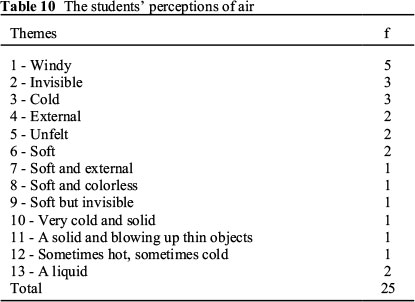
The themes suggest that the students perceived air in different ways. In their descriptions of air, they commonly used words such as windy, invisible, cold, soft, external and unfelt. However, some students considered air as a solid or liquid. None of the students referred to the word "gas" when defining air. Some of their answers are as follows.
S2 It is a windy substance. S3 Air does not exist here; it exists out there and it is soft. S14 I cannot feel air. S9 We cannot see air. S8 Air is a liquid. S6 Air is soft and colorless. S5 It is solid and blows up some thin objects.
Question 6. (Concerning the picture that has a tire, ball and vapour). Which one contains gas and why? The students' answers were grouped under five headings presented in Table 11.
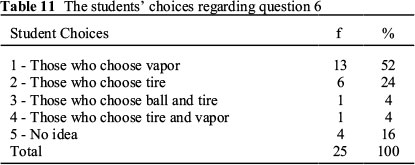
While 52% of the students considered only vapor as a gas, 24% of them picked up tire. Whereas 4% of them chose ball and tire, another 4% picked up tire and vapor. In addition, 16% of them reported that they did not know what gas meant. Out of 13 students who considered vapor as a gas, five did not provide any justification. An analysis was made of the justification by the remaining eight students and related findings are presented in Table 12.
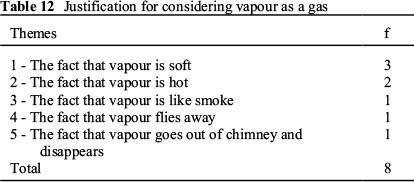
Students justified their answers by reporting that vapor was soft and hot and that it disappeared by flying away like smoke. These statements are actually their perceptions of gas. Some of their answers are as follows.
S1 Gas means soft, vapour has gas, but ball and tire has
water. S5 Vapour has gas, because it is hot; ball has air. S23 Vapour is gas, because it can fly. S25 Vapour is gas; gas is hot. S4 Ball has nothing; vapour means hot, and tire has a very dirty gas.
An analysis of the answers suggests that students defined gases in such expressions as "something that is soft and hot" or "something that can fly away and disappear." Although they viewed vapor as a gas, they did not call air a gas substance.
Perceptions of Melting
Question 7. (Concerning the picture that has water and cube sugar) What happens to the sugar when we put it into water? The students' answers were analyzed and related findings are presented in Table 13.

All the students called the change in the sugar when put into water as melting. An analysis of their answers suggests that they considered dissolving as melting, that they could not discern the difference between melting, a concept they used in their daily lives, and dissolving, and that they experienced misconceptions. Table 14 presents the analysis of the answers by 13 students to the question " What happens to sugar when we put it into water?"
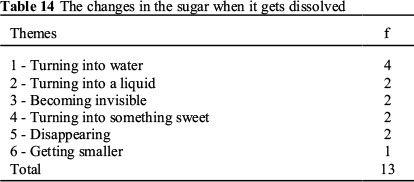
The students reported that sugar turned into water and a liquid, became invisible and disappeared when it got melted. In addition, they stressed that melting caused it to get smaller and to turn into something sweet. Some of their answers are as follows.
S2 When sugar is put into water, it turns into a liquid. S3 It melts and turns into something sweet. S23 It gets melted and we cannot see anything after mixing it. S25 It melts and turns into water. S21 It gets melted and becomes smaller.
Question 8. What does melting mean ? Six of the students had no idea. The answers by the other students were analysed and the findings are presented in Table 15.
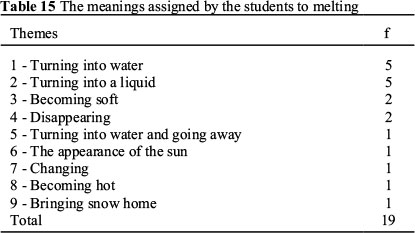
The students commonly defined melting with such words as turning into water, turning into a liquid, becoming soft and disappearing. Some students associated melting with the appearance of the sun, becoming hot and changing. Some of their answers are presented below.
S1 It becomes soft when it melts. S23 When something melts, it changes. S7 Melting means becoming something like water. S22 It means turning into a liquid. S5 It means turning into water and going away. S4 It is called melting when the sun appears.
An analysis of the answers to questions suggests that the students defined melting as turning into water, turning into a liquid, becoming soft and disappearing, becoming hot and changing. In addition, they called dissolving as melting, too.
Perceptions of Freezing
Question 9. What does freezing mean? Five of the students had no idea. Table 16 presents an analysis of the answers by the remaining students.
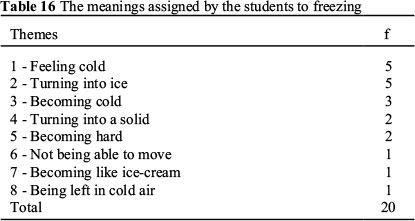
The common perceptions of the students included feeling cold, turning into ice, becoming cold, turning into a solid and becoming hard. Some of their answers are as follows.
S1 Freezing means becoming cold. S12 It means turning into ice. S5 Freezing means feeling cold; we stay where we are. S21 We freeze if we stay outside in cold weather. S3 Freezing means becoming very hard. S8 It means turning into a solid. An analysis of the answers suggests that the students perceived melting as feeling cold, turning into a solid, becoming cold, turning into ice, and becoming hard.
Perceptions of Evaporation
Question 10. How do we evaporate water? Four of the students had no idea. Table 17 presents an analysis of the answers by the remaining students.
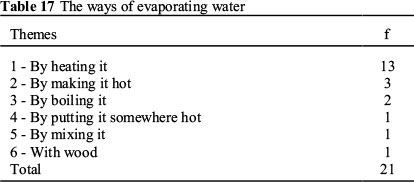
The students thought that in order for water to evaporate it should get heat. Table 18 presents an analysis of the answers by 11 students to the question "What does evaporation mean?"
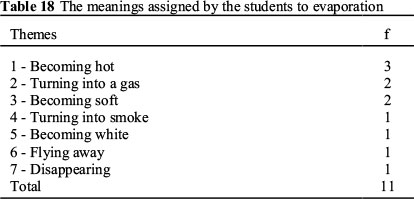
The students described evaporation with such expressions as becoming hot, turning into a gas and becoming soft. Some students associated it with turning into smoke, becoming white, flying away and disappearing. Some of their answers are as follows.
S6 If we put water somewhere cold, it evaporates; evaporation means becoming hot. S23 If we boil water, it evaporates; evaporation means smoke coming out. S12 We put water into a pot, then something happens; it is called evaporation. S7 We heat water and it turns into vapour; evaporation means becoming very soft. S25.
Conclusion and Discussion
The following conclusions were drawn from the present study designed to identify preschoolers' conceptual perceptions of states of matter.
The students could identify solids among given pictures and provide new examples of solid substances. Students believed that in order for a substance to be called a solid it should be hard; therefore, they did not call soft and flexible objects as a solid. For instance, one of the students picked up pencil among some pictures of a nylon bag, rope, fabric, pencil, rubber band and eraser as a solid substance. When asked to justify his/her choice, the student reported that pencil was solid because it was hard whereas others were soft. The finding is supported by that of Tasdemir and Demirbas (2010), who found that sixth and seventh grade students mostly provided accurate examples of solid and liquid substances from their daily life. In another study, Stavy (1991) focused on the views of students from different age groups, namely 6-7, 8-9, 10-11 and 12-13, about the structure of matter. "We use them to do something" or "they help us to do something" are how the students described matter.
In other words, they attempted to define the concept in reference to their daily lives, as was the case for the present study.
The students could distinguish liquids among given pictures and describe them as something wet and soft, something that could flow and be poured, something that resembled water and something that could be drunk. Even so, some of the students wrongly assumed that some non-liquid substances that could flow and be poured were liquids, too. For instance, students were asked whether coffee resembled soup, lentil or soup. Some of them replied that coffee resembled soup and salt because all of them could flow, that coffee resembles soup and salt and it was not a solid, and that coffee resembled all of them because all were liquids and could be poured.
The students did not have as clear an idea about gases as they did about solids and liquids. Some of them reported not knowing what gas meant while others defined it with such expressions as something soft and hot and something that would flow away and disappear. Whereas students viewed vapour as a gas, they did not call air among gases. The common words they used to describe gas included windy, invisible, cold, soft, external and unfelt. In addition, some of the students reported perceiving air as a solid and liquid. In their study on primary and secondary students, Doğar and Başibüyük (2005) reported that air could not be defined exactly by students almost regardless of their grade. Similarly, Stavy (1988) asked eight graders to express their ideas about gases. Whereas they defined gas in reference to their general properties before they received any training, they could define it as a state of matter and explain its properties following the training. In another study, Séré (1986) asked 11-year-old students to comment on gases. Their descriptions of gases were based on their daily-life experiences, as was the case for the present study.
The expressions that the students used to define melting involved turning into water, turning into a liquid, becoming soft, disappearing, the appearance of the stun, becoming hot and changing. They believed that melting entailed heat. In one study, Laçin Şimsek (2007) reported that most students could accurately explain melting since they frequently encountered it in their daily life and it could be explained with simple observations. The students maintained that hard substances could not get melted. Similarly, Laçin Şimşek (2007) reported that, according to students, solid substances should be soft to get melted and asserted that there was a limited image of the subject. Furthermore, the students called solution as melting, too. Some of the answers to the question "What happens to sugar if it is put into water?" were as follows: It melts and turns into a liquid, it melts and we can no longer see it after it has been mixed, and it melts and turns into water. This finding is supported by those of Canpolat and Pinarbaşi, (2003), Tezcan and Bilgin (2004), Çalik and Ayas (2005), Çalik, Ayas and Ünal (2006), Karaer (2007), Konur & Ayas (2008), Özalp and Kahveci (2011), Uluçinar Sağir, Tekin and Karamustafaoğlu (2012). Çalik et al. (2006) attributed the finding to the fact that melting is commonly used instead of solution in daily life.
The students associated freezing with feeling cold, turning into a solid, becoming cold, turning into ice, becoming hard and not being able to move. Some of the answers to the question "What does freezing mean?" were as follows: Freezing means becoming cold, freezing means becoming very hard, and it means turning into a solid. In another study, Boz (2006) concluded that 13 to 17-year-old students had difficulty in understanding states of matters and particular properties of each state, suggesting students' inability to fully understand states of matter or changes of states.
The students thought that evaporation entailed heat. The expressions they used to describe evaporation included becoming hot, turning into a gas, becoming soft, turning into smoke, becoming white, flying away and disappearing. Similarly, Laçin Şimşek (2007) reported that although states of matter is a subject taught starting from grade 4 it is only after grade 8 that students start being aware of the fact that vapour is the gas form of water. Likewise, Kirikkaya and Güllü (2008) reported that fifth graders experienced a number of misconceptions about boiling and evaporation. This is consistent with the finding of the present study that students wrongly defined evaporation as turning into smoke and disappearing.
Recommendations
Teaching concepts start early during childhood and lasts for a life time. Children can be made to learn about concepts in an incorrect way owing to their interactions with their surroundings, their observations, and daily uses of concepts for explaining events. In this respect, it is essential that children should accurately structure concepts starting from an early age. The findings of the present study suggest that students have a number of misconceptions about states of matter and properties of each particular state. Therefore, teachers, especially preschool teachers, are strongly recommended to organize those activities that will enable them to identify their students' basic knowledge of matters. They could conduct interviews with them; alternatively, they could analyze their answers to given questions to detect their misconceptions. Next, they could use conceptual change texts to eliminate these misconceptions and monitor the process continuously. In order for them to be able to do so, preschool teachers should be provided with in-service training sessions. Furthermore, parents should be informed of the process so that students can be enabled to use concepts in an accurate way. Those students that can associate concepts with one another and eliminate misunderstanding will find it easier to comprehend what they will be learning later in their lives.
Note
A part of this study was presented as an oral presentation at the 3rd International Congress on Early Childhood Education, 12-15 September 2012, Adana-Turkey.
References
Awan AS, Khan TM, Mohsin MN & Doger AH 2011. Students' misconceptions in learning basic concept 'composition of matter' in chemistry. International Journal of Applied Science and Technology, 1(4):161-167. Available at http://www.ijastnet.com/journals/Vol_1_No4_July_2011/20.pdf. Accessed 22 June 2014. [ Links ]
Birbili M 2007. Making the case for a conceptually based curriculum in early childhood education. Early Childhood Education Journal, 35(2):141-147. [ Links ]
Botha ML & Reddy CPS 2011. In-service teachers' perspectives of pre-services teachers' knowledge domains in science. South African Journal of Education, 31(2):257-274. Available at http://www.scielo.org.za/pdf/saje/v31n2/v31n2a09.pdf. Accessed 22 June 2014. [ Links ]
Boz Y 2006. Turkish pupils' conceptions of the particulate nature of matter. Journal of Science Education and Technology, 15(2):203-213. doi: 10.1007/s10956-006-9003-9 [ Links ]
Büyükoztürk Ş, Çakmak EK, Akgün ÖE, Karadeniz Ş & Demirel F 2008. Scientific research methods. Ankara: Pegem Academy. (In Turkish). [ Links ]
Çalik M & Ayas A 2003. The preparation and implementation of the concept achievement test for the solution. Pamukkale University Journal of Education, 14(2):1-17. (In Turkish). [ Links ]
Çalik M & Ayas A 2005. 7-10. grade students' understanding about the concept of the chosen solution on a diverse mix of investigation. Journal of Turkish Educational Sciences, 3:329-349. (In Turkish). [ Links ]
Çalik M, Ayas A & Ünal S 2006. Dissolution of student understanding about the concept detection: a comparison study between ages. Journal of Turkish Educational Sciences, 4(3):309-322. (In Turkish). [ Links ]
Canpolat N & Pinarbaşi T 2003. Misconceptions in chemical equilibrium and resolution issues. Science and Engineering Journal of Firat University, 15(1):55-62. (In Turkish). [ Links ]
Carey S 2009. The Origin of Concepts. Oxford: Oxford University Press. [ Links ]
Çepni S, Ayas A, Johnson D & Turgut MF 1997. Physics teaching. Ankara: YÖK/World Bank. (In Turkish). [ Links ]
Çepni S (ed.), Ayas A, Akdeniz A, Özmen H, Yigit N & Ayvaci H 2008. Theory to Practice in Teaching Science and Technology. Ankara: Pegem Academy. (In Turkish). [ Links ]
Coştu B, Ayas A & Ünal S 2007. Misconceptions about boiling and their possible reasons. Kastamonu Education Journal, 15:123-136. (In Turkish). [ Links ]
Devetak I, Vogrinc J & Glažar SA 2010. States of matter explanations in Slovenian textbooks for students aged 6 to 14. International Journal of Environmental and Science Education. 5(2):217-235. Available at http://files.eric.ed.gov/fulltext/EJ884420.pdf. Accessed 23 June 2014. [ Links ]
De Villiers R 2011. Student teachers' views: what is an interesting Life Sciences curriculum? South African Journal of Education, 31:535-548. Available at http://www.ajol.info/index.php/saje/article/viewFile/73746/64430. Accessed 23 June 2014. [ Links ]
Doğar Ç & Başibüyük A 2005. Primary and secondary school students' levels of understanding of weather and climate events. Kastamonu Education Journal, 13(2):347-358. (In Turkish). [ Links ]
Erdem E, Yilmaz A, Atav E & Gücüm B 2004. Students, "matter" of the issue of the level of understanding, misconceptions, attitudes towards science and logical thinking to investigate the levels. Hacettepe University Journal of Education, 27:74-82. (In Turkish). [ Links ]
Evrekli E, Inel D, Balim AG & Kesercioglu T 2009. The attitude scale of constructivist approach for prospective science teachers: a study of validity and reliability. Journal of Turkish Science Education, 6(2):134-148. (In Turkish). [ Links ]
Kamay PO & Kaşker SÖ 2006. My first experience of science. Ankara: SMG Publishing. (In Turkish). [ Links ]
Karaer H 2007. Examination of student teachers' levels of understanding and misconceptions of some concepts about substance and determination regarding to some variablesi. Kastamonu Education Journal, 15(1):199-210. Available at http://perweb.firat.edu.tr/personel/yayinlar/fua_124/124_29190.pdf. Accessed 23 June 2014. (In Turkish). [ Links ]
Karamustafaoğlu S & Kandaz U 2006. Using Teaching Methods in the Science Activities and Difficulties Encountered in Pre School Education. Gazi University Journal of Gazi Educational Faculty, 26(1):65-81. Available at http://www.academia.edu/2948828/Okul_oncesi_egitimde_fen_etkinliklerinde_kullanilan_ogretim_yontemleri_ve_karsilasilan_guclukler. Accessed 23 June 2014. (In Turkish). [ Links ]
Kilinç A 2007. Using concept maps as a teaching strategy. Yüzüncü Yil University Journal of Educational Faculty, 4(2):21-48. Available at http://efdergi.yyu.edu.tr/makaleler/ciltIV/ii/a_kilinc.pdf. Accessed 23 June 2014. (In Turkish). [ Links ]
Kirikkaya EB & Güllü D 2008. Fifth grade students' misconceptions about heat-temprature and evaporation-boiling. Elementary Education Online, 7(1):15-27. [ Links ]
Konur KB & Ayas A 2008. The level of understanding of class teacher candidates' some chemistry concepts. Kastamonu Education Journal, 16(1):83-90. (In Turkish). [ Links ]
Kubiatko M & Prokop P 2009. Pupils' understanding of mammals: an investigation of the cognitive dimension of misconceptions. Orbis Scholae, 3(2):97-112. [ Links ]
Laçin Şimşek L 2007. Elementary students' ideas about basic science concepts. PhD Thesis. Ankara: Gazi University Institute of Education Sciences. (In Turkish). [ Links ]
Malatyali E & Yilmaz K 2010. The importance of concepts in the constructivist learning process: an examination of concepts from pedagogical angle. The Journal of International Social Research, 3(14):320-332. Available at http://www.sosyalarastirmalar.com/cilt3/sayi14pdf/malatyali_e mine_ve_kayayilmaz.pdf. Accessed 23 June 2014. (In Turkish). [ Links ]
MEB (The Ministry of National Education) 2006. Primary school science and technology education curriculum (6, 7 and 8th grades). Ankara. (In Turkish). [ Links ]
Miles MB & Huberman AM 1994. Qualitative data analysis: An expanded sourcebook (2nd ed). California: SAGE Publications. [ Links ]
Nadeem M, Sadaf B, Parveen A & Iqbal S 2013. Representation of science in curriculum related primary school textbooks. Asian Journal of Social Science & Humanities, 2(2):380-387. Available at http://www.ajssh.leena-luna.co.jp/AJSSHPDFs/Vol.2%282%29/AJSSH2013%282.2-40%29.pdf. Accessed 23 June 2014. [ Links ] Özalp D & Kahveci A 2011. Regarding the structure of matter on the basis of a two-stage ontology development of diagnostic questions. National Education Journal, 40(191):135-156. (In Turkish). [ Links ]
Poyraz H & Dere H 2003. Principles and methods of pre-school education. Ankara: Ani Publishing. (In Turkish). [ Links ]
Sendur G, Toprak M & §ahin Pekmez E 2008. The effects of using analogies to prevent misconceptions about evaporation and boiling. Ege Education Journal, 9(2):37-58. (In Turkish). [ Links ]
Séré MG 1986. Children's conceptions of the gaseous state, prior to teaching. European Journal of Science Education, 8(4):413-425. doi: 10.1080/0140528860080408 [ Links ]
Stavy R 1988. Children's conception of gas. International Journal of Science Education, 10(5):553-560. [ Links ]
Stavy R 1991. Children's ideas about matter. School Science and Mathematics, 91(6):240-244. [ Links ]
Taşdemir A & Demirbaş M 2010. The level of correlation of concepts that primary students seen topics in science and technology class with daily life. International Journal of Human Sciences, 7(1):124-148. Available at http://www.j-humansciences.com/ojs/index.php/IJHS/article/viewFile/509/469. Accessed 23 June 2014. (In Turkish). [ Links ]
Tezcan H & Bilgin E 2004. Affects of laboratory method and other factors on the student success in the teaching of the salvation subject at the high schools. Gazi University Journal of Gazi Educational Faculty, 24(3):175-191. Available at http://www.gefad.gazi.edu.tr/window/dosyapdf/2004/3/2004-3-175-191-11-habibetezcan-esrabilgin.pdf. Accessed 23 June 2014. (In Turkish). [ Links ]
Thomson F & Logue S 2006. An exploration of common student misconceptions in science. International Education Journal, 7(4):553-559. [ Links ]
Ülgen G 2004. Concept development theory and practice. Ankara: Nobel Publishing. (In Turkish). [ Links ]
Ulucinar Sagir S, Tekin S & Karamustafaoglu S 2012. The levels of prospective elementary school teachers' understanding of some chemistry concepts. Dicle University Ziya Gdkalp Education Faculty Journal, 19:112-135. Available at http://www.zgefdergi.com/Makaleler/750556339_19_09_ID_263.pdf. Accessed 23 June 2014. (In Turkish). [ Links ] Yildirim A & Şimşek H 2008. Qualitative research methods in the social sciences. Ankara: Seckin Publishing. (In Turkish). [ Links ]
Zirbel EL 2004. Framework for conceptual change. The Astronomy Education Review, 3(1):62-76. [ Links ]
Zirbel EL 2005. Learning, concept formation and conceptual change. Available at http://cosmos.phy.tufts.edu/~zirbel/ScienceEd/Learning-and-Concept-Formation.pdf. Accessed 3 January 2014. [ Links ]
Appendix 1
The science concepts perception test (SCPT)
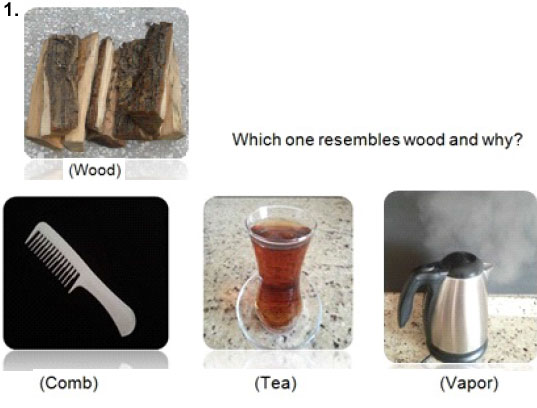
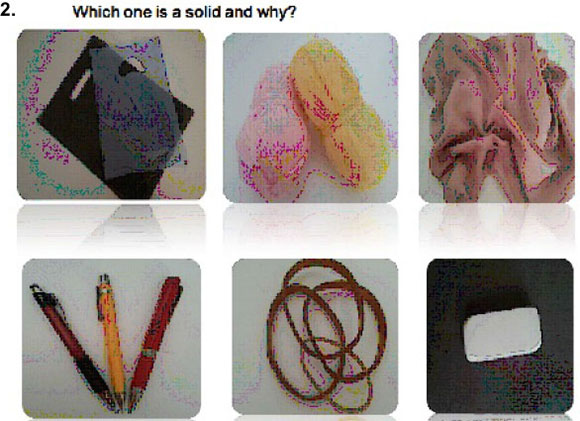
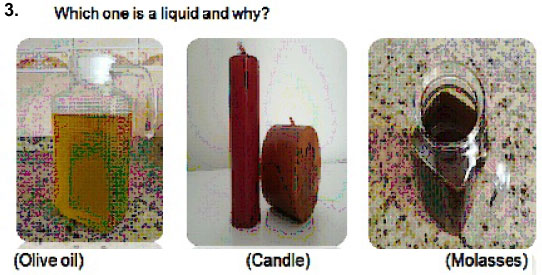
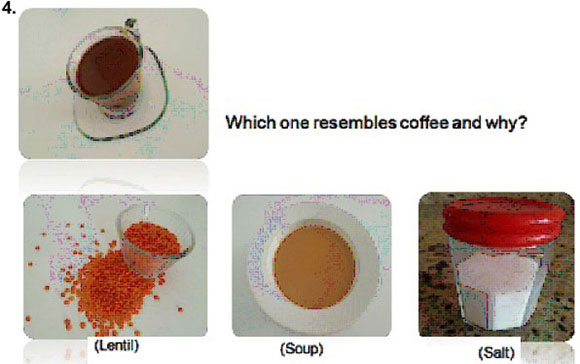
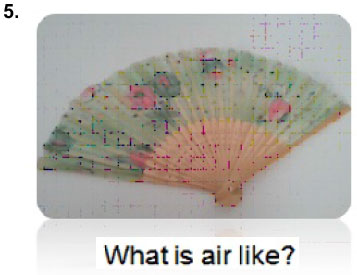
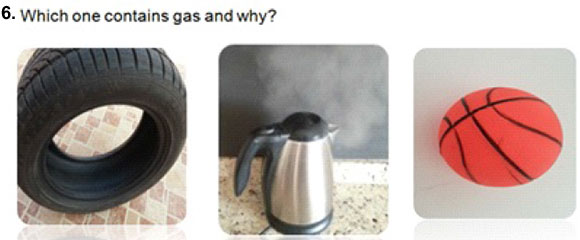
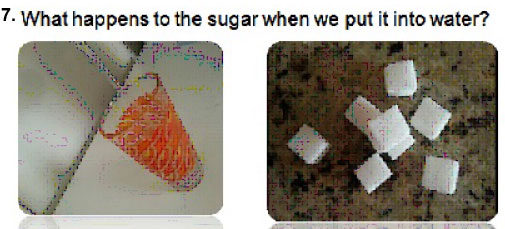
8. What does melting mean?
9. What does freezing mean?
